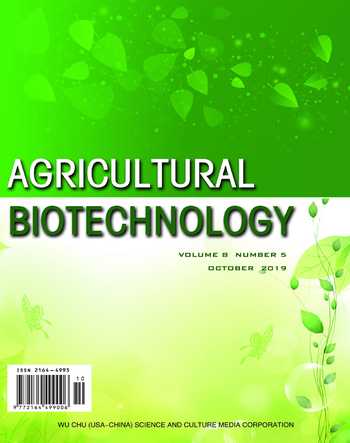Physiological Responses of Different Kinds of Vegetable Seedlings to Polycyclic Aromatic Hydrocarbons Stress
Xuan TANG Minghua LONG Shuangyu QIAO Pengxin LI Huimin ZHANG1 Yongsheng LIANG


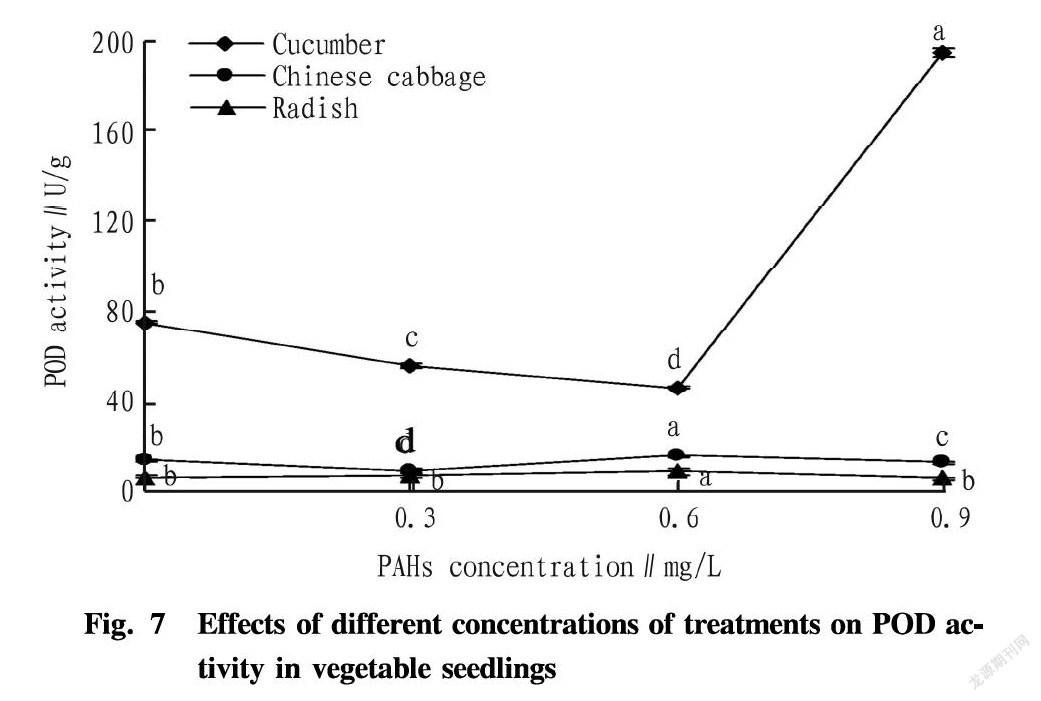



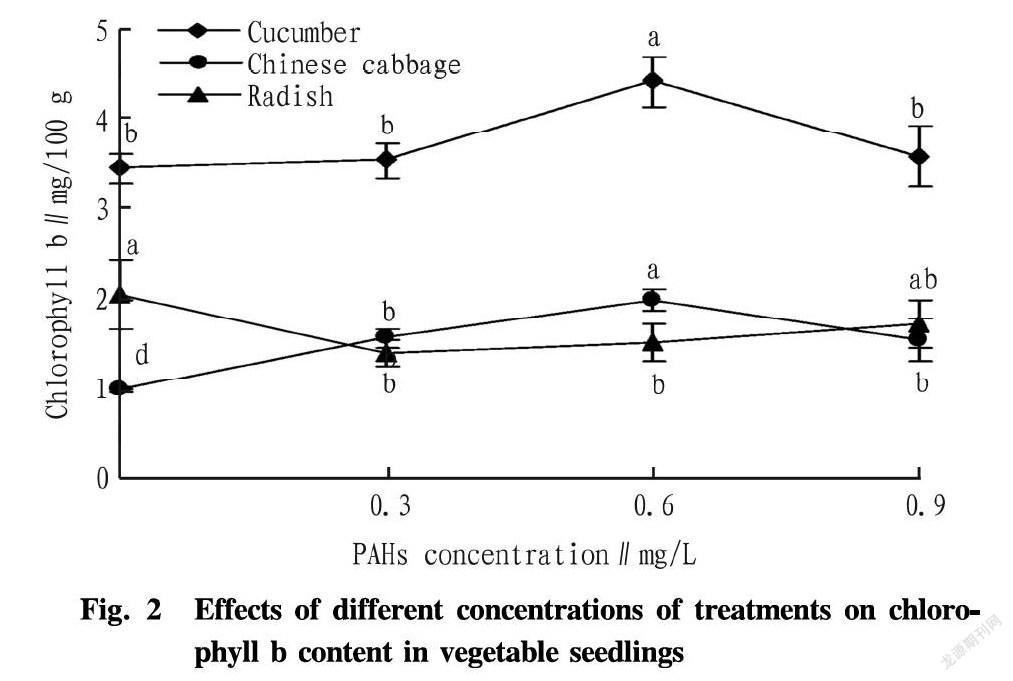

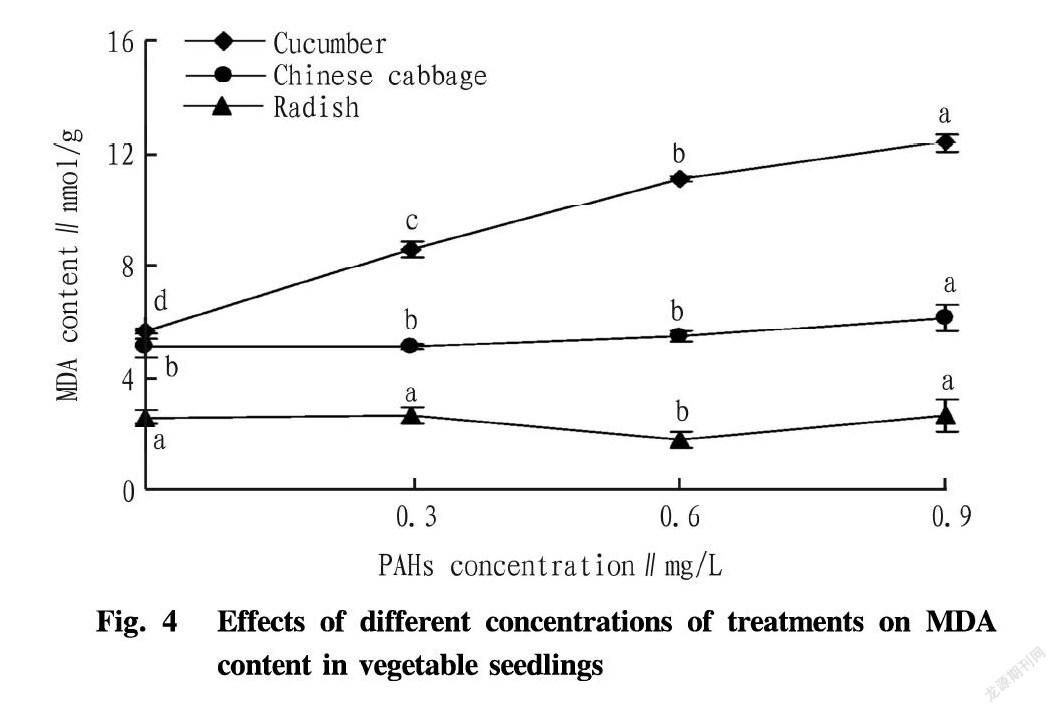
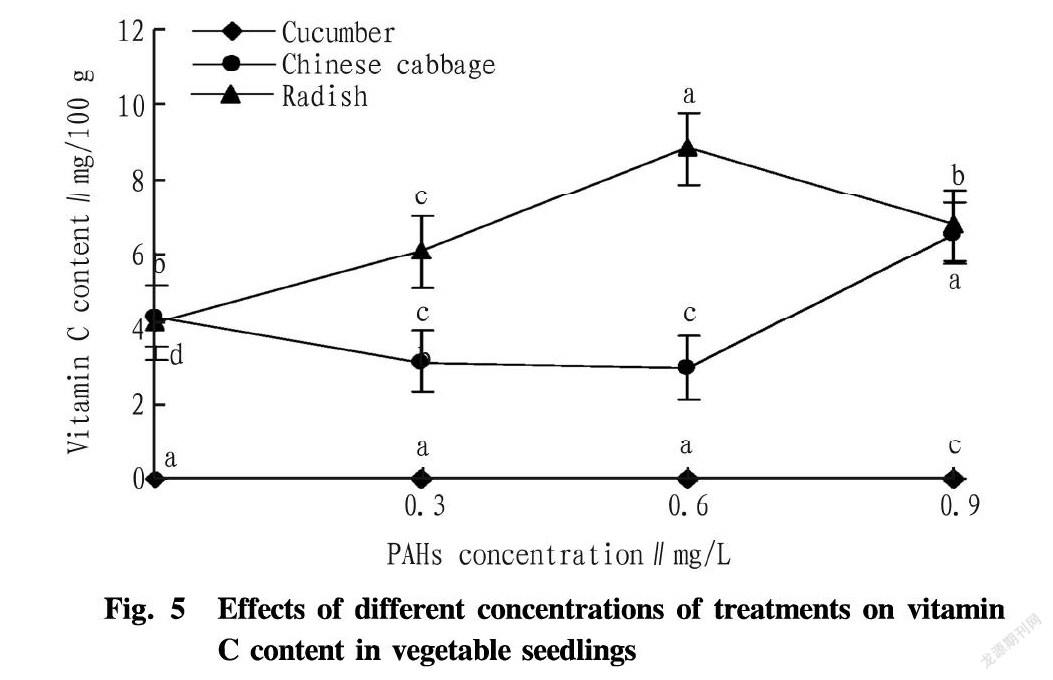
Abstract This study was conducted to explore the effects of polycyclic aromatic hydrocarbons (PAHs) on the growth and physiological characteristics of vegetable seedlings. Cucumber, Chinese cabbage and radish were cultured under the stress of 16 PAHs at different concentrations of 0.3, 0.6 and 0.9 mg/L, respectively, with the seedlings cultured without PAHs as the control, to study the growth and physiological responses of various vegetable seedlings under PAHs stress. The results showed that the leaf width, fresh weight, CAT activity and POD activity of cucumber and the chlorophyll b content and CAT activity of radish reached the minimum values when treated with 0.3 mg/L PAHs. When the treatment concentration was 0.6 mg/L, the POD activity of cucumber, the vitamin C content of Chinese cabbage and the MDA content of radish were the smallest. The dry weight of cucumber, the fresh weight of Chinese cabbage and the fresh weight and POD activity of radish reached the minimums under the treatment of 0.9 mg/L PAHs. Different concentrations of PAHs could promote the synthesis and photosynthesis of chlorophyll in cucumber and Chinese cabbage leaves and the vitamin C content in radish. With the increase of PAHs treatment concentration, the MDA contents of cucumber and Chinese cabbage were on the increase, and reached the maximums under the treatment of 0.9 mg/L PAHs. One of the reasons why different kinds of vegetable seedlings have different physiological responses to PAHs may be related to the differences in the amount of PAHs absorbed by different leaf structures.
Key words Polycyclic aromatic hydrocarbon; Vegetable seedlings; Growth; Physiology and biochemistry
Polycyclic aromatic hydrocarbons (PAHs) are a class of fused ring compounds composed of two or more benzene rings obtained by high-temperature pyrolysis in linear, angular or clustered arrangement. They are hydrophobic and low water-soluble, and can be easily adsorbed on the surface of solid particles. They can exist in the environment for a long time, and are persistent organic pollutants[1-3]. Of the 129 "priority pollutants" proposed by the US Environmental Protection Agency (USEPA) in 1976, 16 are PAH compounds[4-5]. In 1990, Chinas State Environmental Protection Administration listed seven carcinogenic polycyclic aromatic hydrocarbons in the blacklist of environmental priority pollutants in China[6]. PAHs are difficult to degrade in the environment. Because of their semi-volatile and fat-soluble nature, PAHs can be absorbed into plant bodies through plant leaves or into the soil by atmospheric deposition, and migrate, metabolize and accumulate in plants, thereby harming human health through the food chain[7]. There are two main pathways for PAHs to enter plants: the soil-plant pathway and the air-plant pathway[8-9]. It has been reported that this air-plant absorption pathway is the main pathway for plants to absorb PAHs[10-11]. Factors affecting this absorption pathway include the concentration of PAHs in the air, the nature of PAHs, the existing form of PAHs in the air and leaf surface characteristics and temperature. In addition, the surface morphology of the plant leaves, the chemical composition of the epidermis wax, the number and distribution of stomata and the growth of hair are different, and the interaction process between plants and air is different[12]. Moreover, The absorption rate of PAHs by a plant is directly proportional to the adaptation of the plant itself and the bioavailability of PAHs[13].
PAHs pollution is an urgent environmental problem facing the world. Because of their carcinogenic, teratogenic and mutagenic effects, they have a serious impact on human health and have attracted peoples attention. PAHs in the environment can migrate, metabolize and accumulate in plants, thus affecting the normal growth of plants, and they can be scaled up in the food chain, affecting human health. At present, the research on PAHs mainly focuses on the environmental pollution of PAHs and the treatment (bio-remediation) of PAHs-contaminated soils. However, there are relatively few studies on the effects of PAHs stress on vegetable seedlings. In this study, the physiological responses of different kinds of vegetable seedlings to PAHs stress were studied, aiming at laying a foundation for further exploration of the characteristics of different types of vegetables to absorb and enrich PAHs.
Materials and Methods
Materials
Experiment varieties
F508 Youqingtiancaixinwang, produced by Guangzhou Shengjiya Agricultural Technology Co., Ltd.; early radish, Baishaduanye 13, produced by Shantou Baisha Vegetable Original Seed Research Institute; Cucumber, Xiuchuan 701, produced by Guangzhou Weixingli Seed Co., Ltd.
Experiment soil
The matrix was mixed with yellow loam (volume ratio 1∶8) as the test soil.
Preparation of PAH mixture
Sixteen PAHs mixed standards (10 mg/ml) were purchased from Sigma-Alorich, USA. The 16 PAHs were naphthalene (NAP), acenaphthylene (ANY), fluorene (FLU), phenanthrene (PHE), anthracene (ANT), fluoranthene (FLT), pyrene (PYR), benz(a)anthracene (BaA), chrysene (CHR), benzo (b) fluoranthene (BbF), benzo (k) fluoranthene (BkF), benzo[a]pyrene (BaP), indeno(1,2,3-cd)pyrene (IPY), dibenz[a,h]anthracene (DBA), Benzo[g,h,i]perylene (BPE) and Benzo[e]pyrene (BeP). A certain volume of the PAH mixture was added into 500 ml of acetone solution to prepare 0.3, 0.6 and 0.9 mg/L PAH mixtures, which were stored in a refrigerator at 4 ℃ for later use.
Methods
Experiment design
The experiment was conducted in the greenhouse of the vegetable base of the Agricultural College of Guangxi University from July 11 to October 20, 2017. In this experiment, seedlings were raised in trays, and when the seedlings grew to the stage of 2 leaves and 1 heart, they were transplanted into a foam box of 60 cm in length, 45 cm in width and 30 cm in height, 9 plants per box. The leaves of the seedlings were smeared with different concentrations of PAHs 3 d after transplanting, and the untreated vegetable seedlings were used as control. The treatment was performed once every 3 d, for a total of 3 times. Three replicates were set for each treatment.
Index determination
Determination of growth indices: Plant height, leaf length and leaf width, fresh weight and dry weight were measured on the third day after the third treatment. Each treatment was measured with 3 replicates. The aboveground part of the seedlings was then taken back to the laboratory. The surface of the leaves was washed with water and the surface moisture was wiped with filter paper for weighing. After weighing, the plants were wrapped in foil, quickly cooled with liquid nitrogen and stored in a freezer at -40 ℃.
Determination of physiological indices: The chlorophyll content was determined by the acetone extraction method[14]. The vitamin C content was determined by 2,6-dichloroindophenol titration[15]. The malondialdehyde (MDA) content was determined by the thiobarbituric acid (TBA) method. The peroxidase (POD) activity was determined by the guaiacol method; and the catalase (CAT) activity was determined by ultraviolet spectrophotometry[16]. Three replicates were done for each treatment.
Data processing
The experimental data were calculated and plotted using Excel 2013. One-way ANOVA was performed using SPSS 17.0. The least significant difference method (P<0.05, Duncans) was used to compare the differences between the mean values of different treatments.
Results and Analysis
Effect of PAHs stress on the growth of vegetable seedlings
As can be seen from Table 1, Table 2 and Table 3, there were no significant differences in plant height between any two of the PAHs treatments and between the PAHs treatments and the control. The leaf length, fresh weight and dry weight of the cucumber seedlings in the control were significantly higher than those of the PAHs treatments, but there were no significant differences between the PAHs treatments. The leaf width and fresh weight of cucumber reached the minimums in the low concentration PAHs treatment, and were on the increase with the concentration of PAHs increasing. The values increased by 13.36% and 18.19% in the 0.6 PAHs treatment and by 9.98% and 19.57% in the 0.9 mg/L treatment, respectively, compared with those in the 0.3 mg/L PAHs treatment. The dry weight decreased with the increase of PAHs concentration, and the 0.3, 0.6 and 0.9 mg/L PAHs treatments decreased by 34.25%, 36.46% and 38.12%, respectively, compared with the control. There were no significant differences in leaf width and dry weight between the various treatments of cabbage and radish. The fresh weights of Chinese cabbage and radish were the lowest in the high concentration treatment, but the fresh weight of Chinese cabbage was the highest in the control treatment, while radish had the highest fresh weight in the treatment of medium concentration PAHs.
Different lowercase letters following data in the same column indicate significant differences at the 0.05 level. The same below.
Effect of PAHs stress on chlorophyll content of vegetable seedlings
It can be seen from Fig. 1, Fig. 2 and Fig. 3 that the chlorophyll a, chlorophyll b and total chlorophyll contents of cucumber and Chinese cabbage were the highest in the 0.6 mg/L PAHs treatment. There were no significant differences in the chlorophyll a, chlorophyll b and total chlorophyll content of cucumber between the 0.3 and 0.9 mg/L PAHs treatments and the control. The chlorophyll a, chlorophyll b and total chlorophyll contents of Chinese cabbage were the least in the control treatment. The chlorophyll a and total chlorophyll contents of radish were the highest in the 0.9 mg/L PAHs treatment, and there were no significant differences between other treatments and the control treatment. The chlorophyll b content of radish was the largest in the control treatment, and there were no significant differences between other treatments. It indicated that the 0.6 mg/L PAHs treatment promoted the chlorophyll contents of cucumber and Chinese cabbage, and the 0.9 mg/L PAHs treatment promoted the chlorophyll content of radish.
Different lowercase letters in the figure indicate significant differences at the 0.05 level. The same below.
Effect of PAHs stress on malondialdehyde (MDA) content in vegetable seedlings
It can be seen from Fig. 4 that the MDA contents of cucumber and Chinese cabbage increased gradually with the increase of PAHs concentration. The values of the 0.3, 0.6 and 0.9 mg/L PAHs treatments for cucumber increased by 51.85%, 96.86% and 120.24%, respectively, and those of the 0.3, 0.6 and 0.9 mg/L PAHs treatments for Chinese cabbage increased by 0.38%, 6.98% and 20.17%, respectively, compared with the control. The MDA content of radish was the smallest in the 0.6 mg/L PAHs treatment, and there were no significant differences between other treatments. The results showed that under the stress of medium and low concentrations of PAHs, the membrane system of cucumber and Chinese cabbage could work normally. Under the stress of high concentration PAHs, the membrane lipid peroxidation was enhanced and the membrane permeability increased.
Xuan TANG et al. Physiological Responses of Different Kinds of Vegetable Seedlings to Polycyclic Aromatic Hydrocarbons Stress
Effect of PAHs stress on vitamin C content in vegetable seedlings
It can be seen from Fig. 5 that there were no significant differences in vitamin C content of cucumber between the control and various PAHs treatments. Under the treatment of 0.9 mg/L PAHs, the vitamin C content of Chinese cabbage reached the maximum, and the vitamin C content was the smallest under the treatment of 0.6 mg/L PAHs. Under the treatment of 0.6 mg/L PAHs, the vitamin C content of radish reached the maximum, and its vitamin C content was the smallest in the control treatment. Under the treatment of 0.6 mg/L PAHs, the vitamin C content of radish reached the maximum, and the vitamin C content of the control treatment was the smallest. The results showed that the high concentration PAHs treatment significantly promoted the vitamin C content of Chinese cabbage, while the medium concentration PAHs treatment significantly inhibited the vitamin C content of Chinese cabbage. The treatment of PAHs at various concentrations significantly promoted the vitamin C content of radish, and the medium concentration PAHs treatment had the most significant promoting effect on radish.
Effect of PAHs stress on CAT activity of vegetable seedlings
It can be seen from Fig. 6 that the 0.3 and 0.6 mg/L PAHs treatment significantly inhibited the CAT activity of cucumber and significantly promoted the CAT activity of Chinese cabbage. The treatment with 0.3 mg/L PAHs inhibited the CAT activity of radish, while the 0.6 and 0.9 mg/L PAHs treatments promoted the CAT activity of radish, though the effects were not significant. The results showed that the CAT activity of cucumber was sensitive to low and medium concentrations of PAHs, and radish could maintain good free radical scavenging ability under PAHs stress treatment.
Effect of PAHs stress on POD activity in vegetable seedlings
It can be seen from Fig. 7 that the 0.9 mg/L PAHs treatment significantly promoted the POD activity of cucumber, and the 0.6 mg/L PAHs treatment significantly inhibited the POD activity of cucumber. The 0.3 and 0.9 mg/L PAHs treatments significantly inhibited the POD activity of Chinese cabbage, while the treatment with 0.6 mg/L PAHs significantly promoted the POD activity of Chinese cabbage. The treatment with 0.6 mg/L PAHs significantly promoted the POD activity of radish, while there were no significant differences between other treatments. The results showed that the POD activity of different vegetable seedlings had different responses to PAHs stress.
Conclusions and Discussion
Effects of PAHs stress on the growth of vegetable seedlings
Under different concentrations of PAHs, the growth of the tested vegetable seedlings was affected to varying degrees. The leaf width and fresh weight of cucumber reached the minimum values when treated with 0.3 mg/L PAHs, which were 21.97% and 38.84% lower than those of the control treatment, respectively, and the values increased slightly with the increase of PAHs concentration, but were all smaller than the control treatment. The dry weight of cucumber decreased with the increase of PAHs concentration, and reached the minimum value under the treatment of 0.9 mg/L PAHs, which decreased by 38.12% compared with the control treatment. The fresh weight of Chinese cabbage increased first and then decreased with the treatment concentration of PAHs increasing, and reached the minimum value under the treatment with 0.9 mg/L PAHs, which was 27.88% lower than the control treatment. The fresh weight of radish decreased first and then decreased with the increase of PAHs concentration, and reached the minimum value under the treatment of 0.9 mg/L PAHs, which decreased by 17.97% compared with the control treatment. The results showed that the effects of PAHs on the growth and development of the three vegetable seedlings ranked as cucumber > Chinese cabbage > radish.
Effects of PAHs stress on physiological and biochemical indices of vegetable seedlings
Different concentrations of PAHs had a stimulating effect on the synthesis and photosynthesis of chlorophyll in cucumber and Chinese cabbage leaves. Under the treatment of 0.3 mg/L PAHs, the chlorophyll b content of radish reached the minimum, which was 31.80% less than the control treatment. The chlorophyll b content of radish increased gradually with the increase of PAHs concentration, but it was smaller than the control all the time. The results showed that PAHs treatment inhibited the chlorophyll b content of radish. The treatment with different concentrations of PAHs promoted the vitamin C content of radish; under the treatment of 0.6 mg/L PAHs, the content of vitamin C in Chinese cabbage reached the minimum value, which was 31.14% lower than that of the control; and the vitamin C content decreased first and increased then with the treatment concentration increasing, and was higher than the control in the 0.9 mg/L treatment. The results showed that the low and medium concentrations of PAHs treatments inhibited the vitamin C content of radish. MDA is one of the products of membrane lipid peroxidation in biological membrane system. Its content in plants can reflect the degree of lipid peroxidation in the body and indirectly reflect the degree of cell damage. When plants are stressed by external factors, the content of MDA will increase, and the damage to membrane will increase[17]. With the increase of PAHs concentration, the MDA contents of cucumber and Chinese cabbage increased, and reached the maximums under the treatment of 0.9 mg/L PAHs, which increased by 120.24% and 20.17%, respectively. When the concentration of PAHs was 0.6 mg/L, the MDA content of radish was lower than that of the control, which may be due to that the medium concentration of PAHs had certain damage to the normal stress mechanism of radish, resulting in a decrease in MDA content. The results showed that the high concentration PAHs treatment caused lipid peroxidation in cucumber and cabbage.
Enzyme activity is a physiological index of plant sensitivity under PAHs stress. The CAT activity of cucumber and radish had a certain stress response to low concentration of PAHs treatment, and both of them reached their minimum values under the treatment of 0.3 mg/L PAHs, respectively, which were reduced by 57.68% and 54.06%, respectively, compared with the control treatment. The POD activity of Chinese cabbage reached a minimum under the treatment of 0.3 mg/L PAHs, which was 30.13% lower than that of the control treatment. The POD activity of cucumber was the lowest under the treatment of 0.6 mg/L PAHs, which was 38.27% lower than the control treatment. Under the treatment of 0.9 mg/L PAHs, the POD activity of radish reached a minimum, which was 13.13% lower than that of the control treatment. The results showed that the CAT activity of cucumber and radish and the POD activity of Chinese cabbage were sensitive to the low concentration PAHs treatment; the POD activity of cucumber was sensitive to the medium concentration PAHs treatment; and the POD activity of radish was sensitive to the high concentration PAHs treatment.
The absorption rate of PAHs by leaves is greatly affected by the specific surface area of the leaves. Schrelber et al.[18]studied the absorption rate of PAHs by five coniferous species, and the absorption rates of different plants had a good correlation with the specific surface area. The difference in specific surface area of leaves in the same environment may cause the absorption rate to differ by an order of magnitude. The capacity of leaves to absorb and accumulate PAHs is well correlated with the roughness of the leaf surface or the degree of hair density. On the one hand, the leaves of hairy plants are more able to absorb the particulate pollutants in the air, and the dense hair can prevent small water droplets from contacting the waxy surface of leaves, thereby preventing them from taking away the particles attached to the surface of the leaves[19]. Howsam et al.[20]conducted a comparative study of Corylus heterophylla Fisch, Faxinus insularis Hemsl. and Quercus palustris Münchh. in the same environment, and found that the concentration of PAHs in the C. heterophylla leaves with dense hair was 1 times higher than those in F. insularis and Q. palustris leaves with sparse hair. On the other hand, leaves have a physiological phenomenon of drainage, which eliminates some of the particles retained on the leaves. Huang[21]found that the correlations between leaf anatomical structure and PAHs enriching capacities in such four tree species as Cinnamomum camphora, Osmanthus fragrans, Magnolia grandiflora and Loropetalum chinense var. rubrum were significant, and the palisade tissue thickness, sponge tissue thickness and total leaf thickness were in negative correlation with leaf PAHs content. Specifically, the higher the palisade tissue thickness, the sponge tissue thickness, and the total leaf thickness were, then the more convenient the matters in gas and particle states entered the leaves, the higher the adsorption amount was, and the stronger the enrichment effect on the gaseous and particulate PAHs was. However, the correlations between other leaf structures and leaf PAHs content were not significant, probably due to differences in physiological characteristics, in the manifestation that some structural differences were not sensitive to adsorption. For instance, some stratum corneum may be difficult to penetrate; different plants are inconsistent in stomata capacity; and the leaf stomata of different tree species show inconsistent selection of particle size[21]. Barber et al.[22]found that when the stratum corneum is difficult to penetrate and the stomatal density is high, the stomatal absorption pathway is relatively important, and when the stratum corneum is extremely easy to penetrate, the effect of stomata is almost zero. It can be seen that one of the reasons why different kinds of vegetable seedlings have different physiological responses to PAHs may be related to the differences in the amount of PAHs absorbed by different leaf structures.
References
[1]LI YL. Migration regularity of PAHs in soil and its effect on plant growth[D]. Xian: Xian University of Architecture and Technology, 2015. (in Chinese)
[2]HADIBARATA T, KRISTANTI RA. Fate and cometabolic degradation of benzo[a]pyrene by white-rot fungus Armillaria sp. F022[J]. Bioresource Technology, 2012, 107: 314-318.
[3]QUILLIAM RS, RANGECROFT S, EMMETT BA, et al. Is biochar a source or sink for polycyclic aromatic hydrocarbon (PAH) compounds in agricultural soils[J].Global Change Biology Bioenergy, 2013, 5(2): 96-103.
[4]KEITH LH, TELLIARD WA. Priority pollutants I. A perspective view[J]. Environmental Science and Technology, 1979, 13(4):416-423.
[5]CARMICHAEL LM, CHRISTMAN RF, PFAENDER FK. Desorption and mineralization kinetics of phenanthrene and chrysene in contaminated soils[J]. Environmental Science and Technology, 1997, 31 (1): 126-132.
[6]LIU WW. Remediation of polycyclic aromatic hydrocarbons (PAHs): Contaminated arable soils by bio-synergistic method and organic wastes eco-regulation[D]. Nanjing: Nanjing Agricultural University, 2009. (in Chinese)
[7]YIN J, XIA ZH, ZHOU YC, et al. Characterization and cancer risk assessment of PAHs in vegetables sold in Lifen City, China[J]. Asian Journal of Ecotoxicolog, 2016, 11(3): 265-271. (in Chinese)
[8]COBBETT CS, MEAGHER RB. Arabidopsis and the genetic potential for the phytoremediation of toxic elemental and organic pollutants[J].The Arabidopsis Book, 2002, 1: e0032.
[9]HARVEYP J, CAMPANELLA BF, CASTRO PML, et al. Phytoremediation of polyaromatic hydrocarbons, anilines and phenoles[J].Environmental Seience Pollution Research International, 2002, 9(1): 29-47.
[10]WILD SR, JONES KC. The significance of polynuclear aromatic hydrorbons applied to agricultural soils in sewage sludges in the UK[J]. Waste Management and Research, 1994, 12(1):49-59.
[11]HORSTMANN M, MCLACHLAN MS. Atmospheric deposition of semivolatile organic compounds to two forest canopies[J]. Atmospheric Environment, 1998, 32(10): 1799-1809.
[12]TRAPP S, MCFARLANE JC. Plant contamination: modeling and simulation of organic chemical process[M]. Boca Raton: Lewis, 1995:254.
[13]XU SY, CHEN YX, WU WX, et al. Enhanced dissipation of phenanthrene and pyrene in spiked soils by combined plants cultivation[J]. Science of the Total Environment, 2006, 363(1/2/3): 206-215.
[14]ZHANG ZL, QU WJ, LI XF. The guidance of plant physiology experiment[M]. Beijing: Higher Education Press, 2009. (in Chinese)
[15]LIU P, LI MJ. Plant physiology experiment techniques[M]. Beijing: Science Press, 2007. (in Chinese)
[16]LU WJ, LI YS. Plant physiology experiment course[M]. Beijing: China Forestry Publishing House, 2012. (in Chinese)
[17]TEWARI RK, KUMAR P, SHARMA PN. Magnesium deficiency induced oxidative stress and antioxidant responses in mulberry plants[J]. Scientia Horticulturae, 2006, 108(1): 7-14.
[18]SCHRELBER L, SCHONHERR J. Uptake of organic chemicals in conifer needles: surface adsorption and permeability of cuticles[J]. Environmental Science & Technology, 1992, 26:153-159.
[19]LITTLE P, WIFFEN RD. Emission and deposition of petrol engine exhaust Pb I: Deposition of exhaust Pb to plant and soil surface[J]. Atoms Environ, 1977, 11(5): 437-447.
[20]HOWSAM M, JONES KC, MEASON P. PAHs associated with the leaves of three deciduous tree species: I. Concentrations and profiles[J]. Environmental Pollution, 2000, 108: 413-424.
[21]HUANG Y. Changes in PAHs content in leaves of urban green plants and effects of PAHs on soil microbes and enzymes[D]. Changsha: Central South University of Forestry and Technology, 2011. (in Chinese)
[22]BARBER JL, KURT PB, THOMAS GO, et al. Investigation into the importance of the stomatal pathway in the exchange of PCBs between air and plants[J]. Environmental Science & Technology, 2002, 36: 4282-4287.
- 农业生物技术(英文版)的其它文章
- Analysis of the Southern China Tilapia Production and Economic Benefits of Different Breeding Patterns in 2018
- Dynamic Monitoring and Control Measures of Spodoptera frugiperda (J.E.Smmith) in Low Latitude Plateau Sugarcane Areas
- Control Effects of a New Sex Pheromone Trap and Biological Agents on Sesamia inferens Walker and Argyroploce schistaceana (Snellen)
- Comparative Study on Grain Cadmium Content and Yield in Different Rice Varieties
- Simulation Experiment of Air Temperature Variation in Multi-film Covering at Night
- Identification of Growth-promoting Bacteria from Rhizosphere of Pastures and Their Effects on Growth of Lotus corniculatus L.

